| Submitted By: Nedra Garrett
/ CDC
|
| Data Element Information |
| Rationale for Separate Consideration |
The concept of Usual Work encompasses multiple unique, independent data elements and so should be its own Data Class. |
| Use Case Description(s) |
| Use Case Description |
Support research and public health, including case reporting (eCR) and MedMorph; used to understand and quantify occupation-related exposures and risks for infectious and non-infectious conditions. The added specificity of Usual Occupation Start Date and Usual Occupation Duration makes it possible to consider the impact of time and extent of exposure across populations.
--Example 1: investigate causes of interstitial lung disease and requirements for lung transplants using data from existing patient registries. Related websites:
NIOSH Data and Statistics Gateway: https://www.cdc.gov/niosh/data/default.html
Work-Related Lung Disease Surveillance System (e(WoRLD)): https://wwwn.cdc.gov/eworld
Electronic Case Reporting (eCR): https://www.cdc.gov/ecr/index.html
--Example 2: investigate the relationship between work and causes of death or cancer. Collecting and recording these data as standardized data elements will reduce the burden of translating text into codes, which may include misspellings and inadequate information. Related websites:
National Program of Cancer Registries: https://www.cdc.gov/cancer/npcr/
National Vital Statistics System, Mortality Statistics: https://www.cdc.gov/nchs/nvss/deaths.htm |
| Estimate the breadth of applicability of the use case(s) for this data element
|
Approximately 75% of adults age 18 and older had worked in the past 12 months and on average approximately 60% of adults in the U.S. currently are working (2018). Only 5% of adults report that they have never worked. Since work and health are interrelated, most providers involved in direct patient care would potentially benefit from the capture, access, use, and exchange of Usual Work information. Includes:
--209,000 primary care physicians
--many of the 120,000 certified physician assistants and 290,000 licensed nurse practitioners
--many of the 415,000 specialty physicians who are also primarily involved in direct patient care, e.g., those who care for injuries and are faced with return-to-work decisions, such as emergency medicine specialists, orthopedists, physiatrists; those who care for patients with chronic diseases caused by occupational exposures, such as pulmonologists, neurologists, nephrologists, and oncologists.
AHA (2018) reported 6,146 hospitals in the US experiencing 36,353,946 admissions. All hospitals and ambulatory care providers who diagnose or treat cancer are required to report to state cancer registries.
There are approximately 2.8 million deaths in the U.S. annually. Vital records death reporting from Electronic Death Registration Systems (EDRSs) to multiple public health agencies, including the National Association for Public Health Statistics and Information Systems (NAPHSIS), the National Center for Health Statistics (NCHS), and surveillance programs such as cancer. |
| Link to use case project page |
https://www.cdc.gov/csels/phio/making-ehr-data-more-available.html |
| Supporting Attachments |
LTR.Tripathi.23.Sep.2021
EPICJuly 2021 -- ehr letter.sent
Healthcare Surveillance for Pandemic Response_eCR_Showcase
|
| Use Case Description |
1) Collect and use data that address “conditions in the places where people … work … that affect a wide range of health and quality-of life-risks and outcomes,", i.e., work as a social determinant of health (SDOH) https://www.cdc.gov/socialdeterminants/index.htm . Work and health are inextricably related, regardless of whether a condition is work-related: in the U.S., workers spend more than half their waking hours at work, approximately 75% of adults have worked in the past 12 months, and 95% have worked at some time in their lives.
--Example: a cashier in a bicycle shop with shortness of breath and cough receives a diagnosis of silicosis after his physician sees that the patient’s usual work has been in the manufactured countertop installation industry. The patient is referred to a specialist who can evaluate whether workplace exposures caused the patient’s respiratory symptoms and provide information about how to avoid exposures in the bike shop and elsewhere.
2) Support recognition, diagnosis, and management of chronic conditions which evolve over many years and may become evident after the person is no longer performing that type of work. Prevent associated conditions from occurring, e.g., TB in persons with silicosis. A person might not think to mention their Usual Work in relation to a health concern.
--Example: a retired pipe welder might currently be working as a department store door greeter, but still suffering health effects of long-term exposure to welding fumes and vibration.
--Usual Industry may explain the risk for a disease, e.g., shipbuilding involved the use of asbestos in many aspects of work. Exposure was a characteristic of that industrial environment, not specific to occupation.
--The added specificity of Usual Occupation Start Year and Usual Occupation Duration makes it possible to consider the impact of time and extent of exposure.
--Some known conditions include asbestosis, silicosis, berylliosis, and interstitial pulmonary fibrosis, cancer, and musculoskeletal disorders.
3) Support recognition of new work-related conditions and quickly identify at-risk populations to prevent further illness.
--Example: in 2000, an astute clinician’s knowledge of patients’ previous employment in a popcorn flavoring manufacturing facility led to recognition of the link between an irreversible fixed obstructive lung disease and inhalation of butter flavoring chemicals at work. If a structured Usual Work element had been available in an electronic heath record system, this link might have been recognized sooner; a review subsequently found the relationship between occupational hazard exposure and this condition as far back as 1985. MMWR 2002 Apr 26;51(16):345-7. https://www.cdc.gov/mmwr/preview/mmwrhtml/mm5116a2.htm
4) Facilitate access to clinical decision support, e.g., through use of CQL. |
| Estimate the breadth of applicability of the use case(s) for this data element
|
Approximately 75% of adults age 18 and older had worked in the past 12 months and on average approximately 60% of adults in the U.S. currently are working (2018). Only 5% of adults report that they have never worked. Since work and health are interrelated, most providers involved in direct patient care would potentially benefit from the capture, access, use, and exchange of Usual Work information. Includes:
--209,000 primary care physicians
--many of the 120,000 certified physician assistants and 290,000 licensed nurse practitioners
--many of the 415,000 specialty physicians who are also primarily involved in direct patient care, e.g., those who care for patients with chronic diseases caused by occupational exposures, such as pulmonologists, neurologists, nephrologists, and oncologists. |
| Link to use case project page |
https://www.cdc.gov/niosh/topics/default.html |
| Use Case Description |
1) Reduce burden of data collection:
--Removes the need for an entire job history to determine usual work. Usual Work may be across multiple jobs and may not be the person’s current job.
--Support patient-entry/review/update at or prior to registration for adults, e.g., via a patient portal, in-office kiosk or tablet, sharing from a personal health record (PHR).
2) Improve quality of care by exchange of medical information (transitions of care, referrals, patient summaries, etc.) to provide a more complete and computable picture of factors that may affect the patient’s health. This will also reduce the need for data reentry.
3) Contribute, potentially, to patient matching algorithms.
4) Address important administrative aspects of work-related illnesses and injuries, such as compensation for the condition and access to benefits to assist in care. |
| Estimate the breadth of applicability of the use case(s) for this data element
|
Approximately 75% of adults age 18 and older had worked in the past 12 months and on average approximately 60% of adults in the U.S. currently are working (2018). Only 5% of adults report that they have never worked. Since work and health are interrelated, most providers involved in direct patient care would potentially benefit from the capture, access, use, and exchange of Usual Work information. Includes:
--209,000 primary care physicians
--many of the 120,000 certified physician assistants and 290,000 licensed nurse practitioners
--many of the 415,000 specialty physicians who are also primarily involved in direct patient care, e.g., those who care for patients with chronic diseases caused by occupational exposures, such as pulmonologists, neurologists, nephrologists, and oncologists. |
| Link to use case project page |
https://www.cdc.gov/niosh/topics/ehr/default.html |
| Healthcare Aims |
- Improving patient experience of care (quality and/or satisfaction)
|
| Maturity of Use and Technical Specifications for Data Element |
| Applicable Standard(s) |
N/A |
| Additional Specifications |
HL7 CDA® R2.1 IG: Consolidated CDA Templates for Clinical Notes; Occupational Data for Health, STU R1.1 – US Realm. http://www.hl7.org/implement/standards/product_brief.cfm?product_id=522 (Modular template for non-breaking insertion of Usual Work (and/or other ODH sections) for any CDA IG social history section)
HL7 FHIR R4.0.1 Profile: Occupational Data for Health (ODH), R1, STU 1.1. http://hl7.org/fhir/us/odh/STU1.1/ (Modular template for non-breaking insertion of Usual Work (and/or other ODH profiles) for any FHIR IG social history section)
Public health IGs including Usual Work:
--HL7 CDA R2 IG Public Health Case Report – the Electronic Initial Case Report (eICR), R1, STU R2 – US Realm. http://www.hl7.org/implement/standards/product_brief.cfm?product_id=436 (also STU R3, to be published late 2021 and implemented starting in 2022)
--HL7 FHIR R4 IG: Electronic Case Reporting (eCR) – US Realm, R1, STU 1. http://hl7.org/fhir/us/ecr/history.html (also R2, to be published late 2021 and implemented starting in 2022)
--HL7 CDA R2 IG: Reporting to Public Health Cancer Registries from Ambulatory Healthcare Providers, R1, Draft STU R1.1 – US Realm. http://www.hl7.org/implement/standards/product_brief.cfm?product_id=398 (Usual Work is required)
--HL7 FHIR R4.0.1 IG: Vital Records Mortality and Morbidity Reporting, R1, STU 1. http://hl7.org/fhir/us/vrdr/history.html (Usual Occupation and Usual Industry required in decedent demographics for reporting from vital statistics agencies to the national statistical agency)
--HL7 CDA R2 IG: Vital Records Death Reporting, R1, STU 2.1 – US Realm. http://www.hl7.org/implement/standards/product_brief.cfm?product_id=386 (Usual Occupation and Usual Industry required in decedent demographics for reporting from vital statistics agencies to the national statistical agency)
IHE Patient Care Coordination (PCC) Technical Framework (TF) Supplement: CDA Content Modules, Revision 2.7 – Trial Implementation. https://www.ihe.net/resources/technical_frameworks/#pcc (Modular template for non-breaking insertion of Usual Work (and/or other ODH sections) for any CDA profile social history section)
CDC/NIOSH. “A Guide to the Collection of Occupational Data for Health.” https://www.cdc.gov/niosh/topics/ehr/default.html
HL7 EHRS-FM R2: Functional Profile; Work and Health, R1 – US Realm. http://www.hl7.org/implement/standards/product_brief.cfm?product_id=498
Marovich S, Luensman GB, Wallace B, Storey E. Opportunities at the intersection of work and health: Developing the occupational data for health information model. J Am Med Inform Assoc. 2020 Jul 1;27(7):1072-1083. https://doi.org/10.1093/jamia/ocaa070
Additional IHE PCC TF Supplements including Usual Work: https://www.ihe.net/resources/technical_frameworks/#pcc :
--IHE PCC TF Supplement to Volume 1, CDA Occupational Data Options, Revision 1.1 – Trial Implementation adds Usual Work (and other ODH sections) to:
(a) Cross-Enterprise Sharing of Medical Summaries (XDS-MS)
(b) Exchange of Personal Health Record (XPHR)
(c) Emergency Department Referral (EDR) profiles
--IHE PCC TF Supplement: Query for Existing Data for Mobile (QEDm), Revision 2.2 – Trial Implementation
--IHE PCC TF Supplement: International Patient Summary (IPS), Revision 1.1 – Trial Implementation
Federal Health Information Model (FHIM), Person Domain. https://fhim.org/
IHE Quality, Research and Public Health (QRPH) TF Supplement: Healthy Weight (HW), Revision 2.4 – Trial Implementation (includes Usual Work) https://www.ihe.net/resources/technical_frameworks/#qrph
HL7 Version 2.9 Messaging Standard – An Application Protocol for Electronic Data Exchange in Healthcare Environments, Normative. (includes Usual Work) http://www.hl7.org/implement/standards/product_brief.cfm?product_id=516 |
| Current Use |
This data element has been used at scale between multiple different production environments to support the majority of anticipated stakeholders |
| Supporting Artifacts |
Certification Criteria for § 170.315(f)(4), cancer reporting. https://www.healthit.gov/isa/standards-version-advancement-process . The Certified Health IT Product List (CHPL) lists 288 EHR or HIT Module products certified to (f)(4) using this standard (https://chpl.healthit.gov/#/search ).
Two electronic death registration systems (EDRSs) transmitted Usual Work in the ODH template to the national vital statistics system at the HL7 FHIR Connectathon, Sept. 2020 (https://confluence.hl7.org/display/FHIR/2020-09+Public+Health+Track ).
Testing and demonstrations for HIMSS Interoperability Showcases 2016-2019 and the PHI Conference Interoperability Showcases in 2016 and 2018 used the IHE Healthy Weight (HW) profile. Involved 3 personal health records, 1 interface engine, 1 public health representative, 1 provider portal, and 1 EHR using a test environment. Deployed in interface engine production product.
Testing and demonstration for HIMSS Interoperability Showcase 2021, MedMorph, 2 EHRs implemented.
Related References:
“Health and Fitness,” Interoperability Showcase. Health Information Management and Systems Society (HIMSS) Annual Conference. Feb 19-24, 2017. Video at https://www.youtube.com/watch?v=ZxRx1UECUkg&list=PLFB222C2B798A2877&t=0s&index=22
“Value-Based Care,” Interoperability Showcase. HIMSS Annual Conference. Las Vegas, NV. Mar 5-8, 2018. Video available at https://www.youtube.com/watch?v=JH4Y4pV3mw8&t=0s&index=7&list=PLGFNwETCTdKlvMmCk0XjXksTDMW57kxUx
“Patient-Centered Interoperability,” Interoperability Showcase. HIMSS Annual Conference. Orlando, FL. Feb 11-15, 2019. Video available at https://www.youtube.com/watch?v=0ZCyjHG8Kpo&t=584s
https://www.cdc.gov/niosh/topics/ehr/default.html
|
| Extent of exchange
|
5 or more. This data element has been tested at scale between multiple different production environments to support the majority of anticipated stakeholders. |
| Supporting Artifacts |
The Certified Health IT Product List (CHPL) lists 288 EHR or HIT Module products certified to (f)(4) using a standard that includes Usual Occupation and Usual Industry (https://chpl.healthit.gov/#/search).
Testing and demonstration for HIMSS and NACCHO 360X Interoperability Showcases has involved 3 personal health records, 1 interface engine, 1 public health representative, 1 provider portal, and 2 EHRs.
Two electronic death registration systems (EDRSs) transmitted Usual Occupation and Usual Industry to the national vital statistics system at the HL7 FHIR Connectathon, Sept. 2020 (https://confluence.hl7.org/display/FHIR/2020-09+Public+Health+Track ).
Usual Work will be included in the upcoming (fall 2021) public health case reporting CDA R3 and FHIR R2 IGs, which CDC will be working with EHR vendors to implement in 2022.
Usual Work will be included in the MedMorph FHIR content IG for cancer reporting, under development.
https://www.cdc.gov/niosh/topics/ehr/default.html
|
| Potential Challenges |
| Restrictions on Standardization (e.g. proprietary code) |
The value sets for Occupation and Industry suggested in some interoperability standards are the CDC_Census2010 category value sets. However, the new ODH Occupation and Industry value sets assist with self-selection of coded entries that provide detail to support patient care. Crosswalks from ODH to CDC_Census2010 codes are available in the PHIN VADS Hot Topics section. A non-breaking “translation” in CDA or “slice” in FHIR can be used to transmit either or both ODH or CDC_Census2010 values; all relevant HL7 interoperability IGs and IHE interoperability content profiles are being updated accordingly. The translation is in the upcoming public health IGs. |
| Restrictions on Use (e.g. licensing, user fees) |
none |
| Privacy and Security Concerns |
Usual Work is intended to be a part of the medical record and protected as such. |
| Estimate of Overall Burden |
We estimate that it will take approximately 200 hours to implement Usual Work as described in the HL7 EHRS Work and Health Functional Profile and “A Guide for Collection of Occupational Data for Health (ODH).”
Initially, data collection will likely occur primarily via patient self-entry. Based on usability testing of a data collection prototype, initial entry of all ODH (Job, Usual Work, Employment Status and Retirement Date, and Combat Zone Period) takes 5-30 minutes. As with other EHR data classes, such as medications and family history, the opportunity to review previously entered information will be key to reducing the collection burden. Leveraging interoperability standards will also help to minimize the collection burden by sharing the information across systems. |
| Other Implementation Challenges |
The ODH value sets for Occupation and Industry are large, in order to provide recognizable terms. However, keyword text searches can be used to facilitate selection as described in the NIOSH “A Guide to Collection of Occupational Data for Health (ODH).” |
ASTP Evaluation Details
Each submitted Data Element has been evaluated based on the following criteria. The overall Level classification is a composite of the maturity based on these individual criteria. This information can be used to identify areas that require additional work to raise the overall classification level and consideration for inclusion in future versions of USCDI
|
Criterion #1
Maturity - Current Standards |
Level 2
- Data element is represented by a terminology standard or SDO-balloted technical specification or implementation guide.
|
Criterion #2
Maturity - Current Use
|
Level 1
- Data element is captured, stored, or accessed in at least one production EHR or HIT module.
|
Criterion #3
Maturity - Current Exchange |
Level 1
- Data element is electronically exchanged between two production EHRs or other HIT modules using available interoperability standards.
|
Criterion #4
Use Case(s) - Breadth of Applicability |
Level 0
- Use cases apply to a limited number of care settings or specialties, or data element represents a specialization of other, more general data elements.
|
| Evaluation Comment |
This data element represents a component of an existing USCDI data element Occupation in the Patient Demographics/Information data class, and is used in a relatively narrow use case. |
|
 Official Website of the Assistant Secretary for Technology Policy/Office of the National Coordinator for Health IT
Official Website of the Assistant Secretary for Technology Policy/Office of the National Coordinator for Health IT

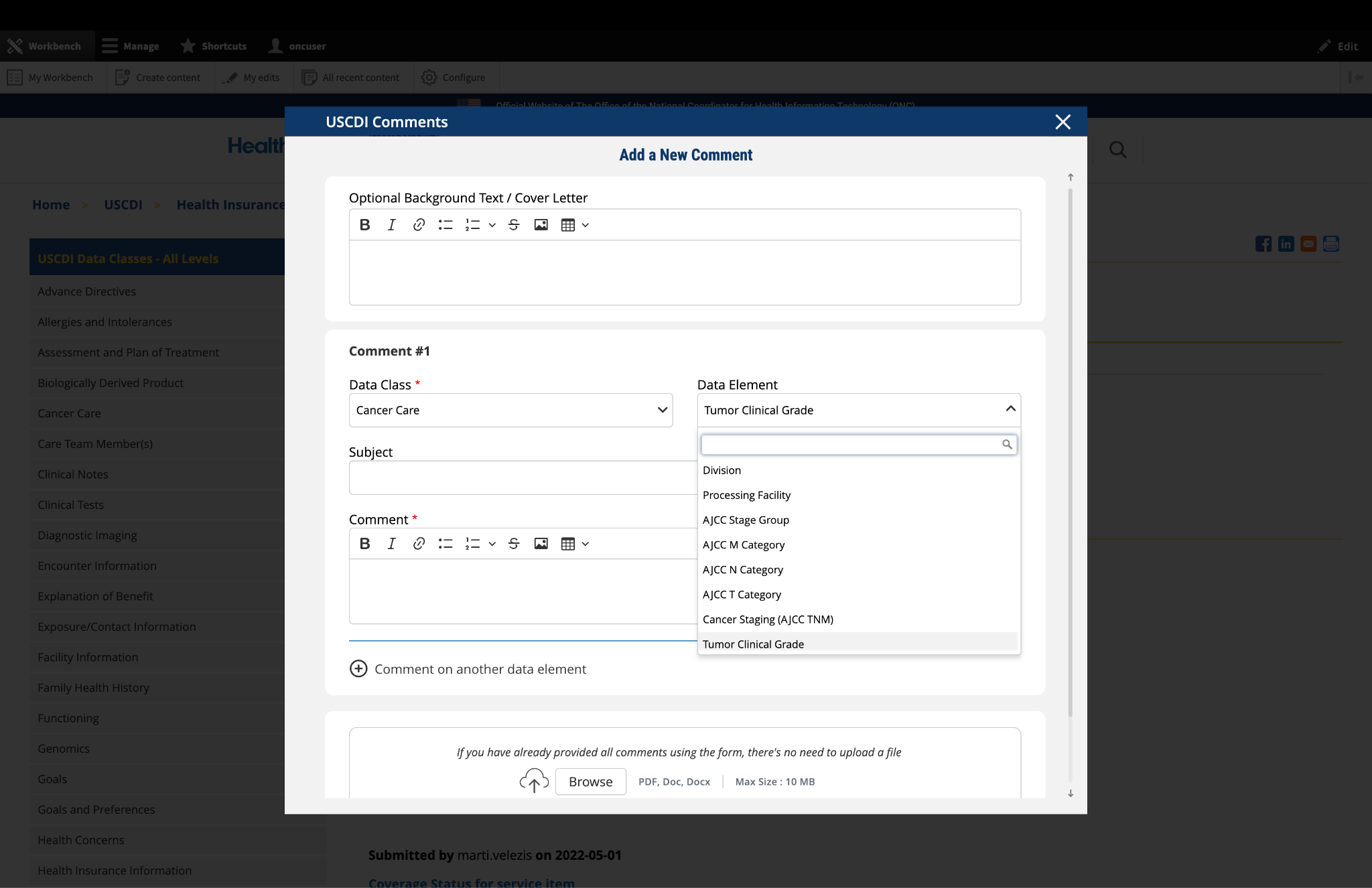
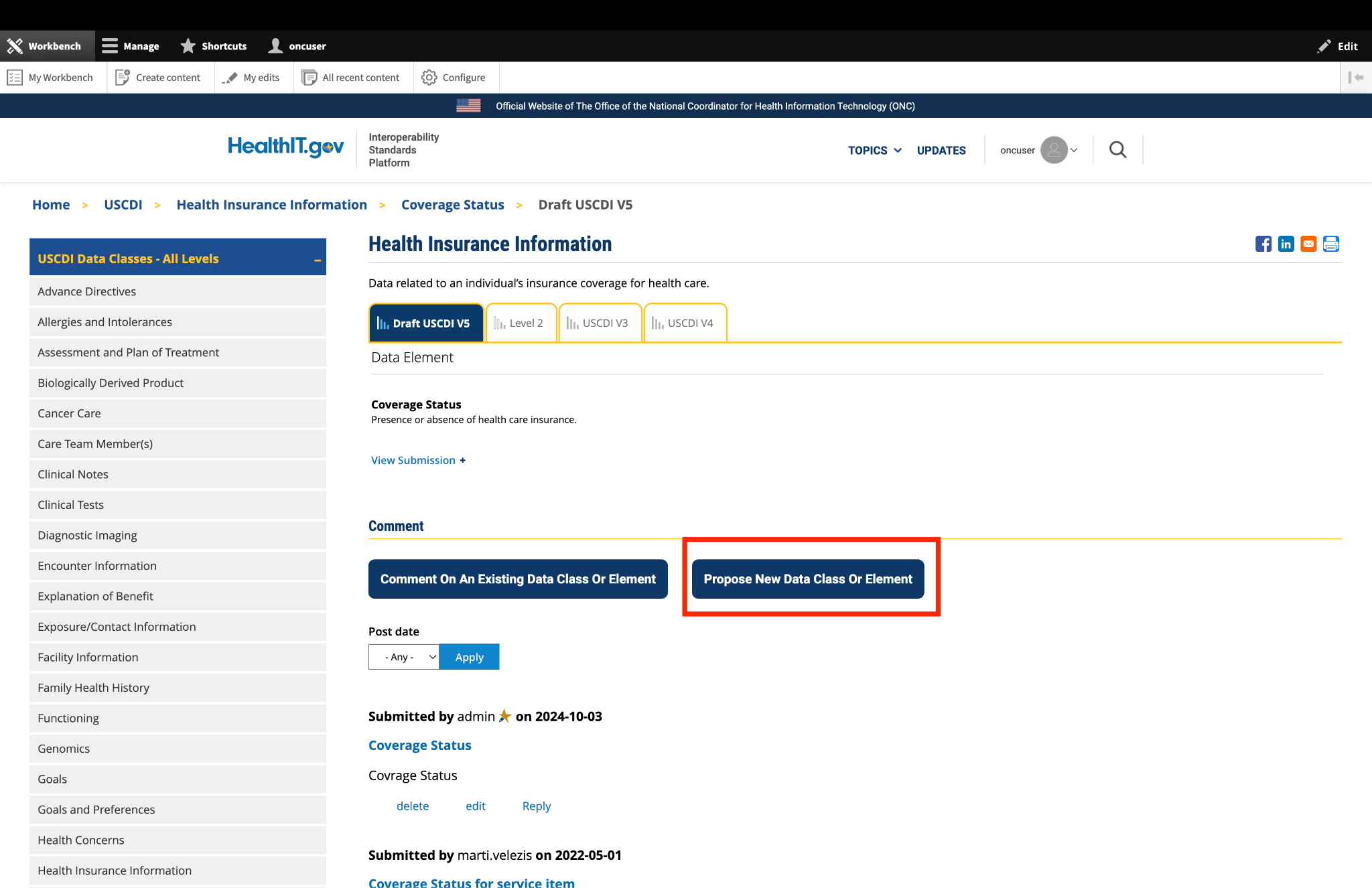
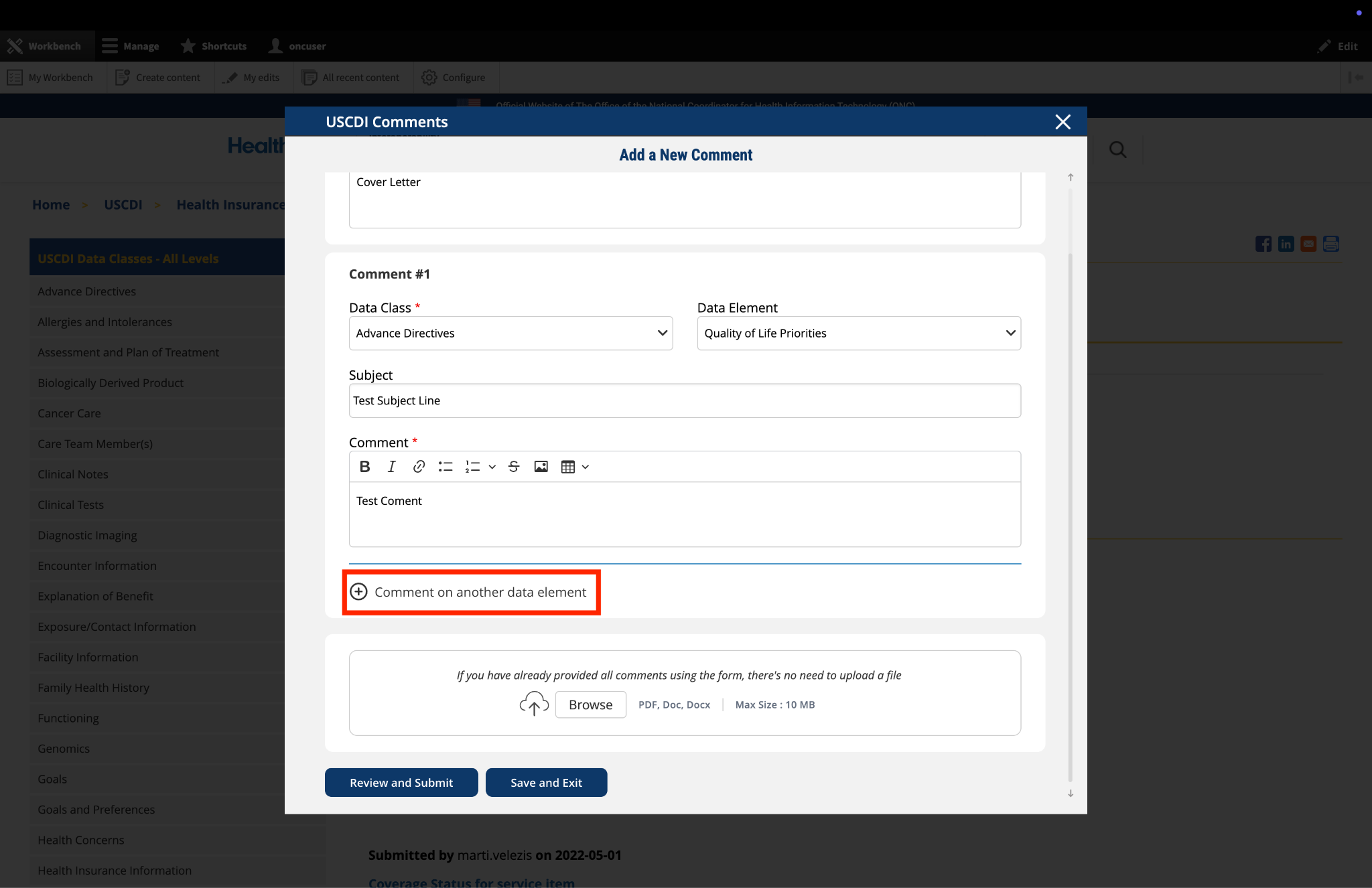
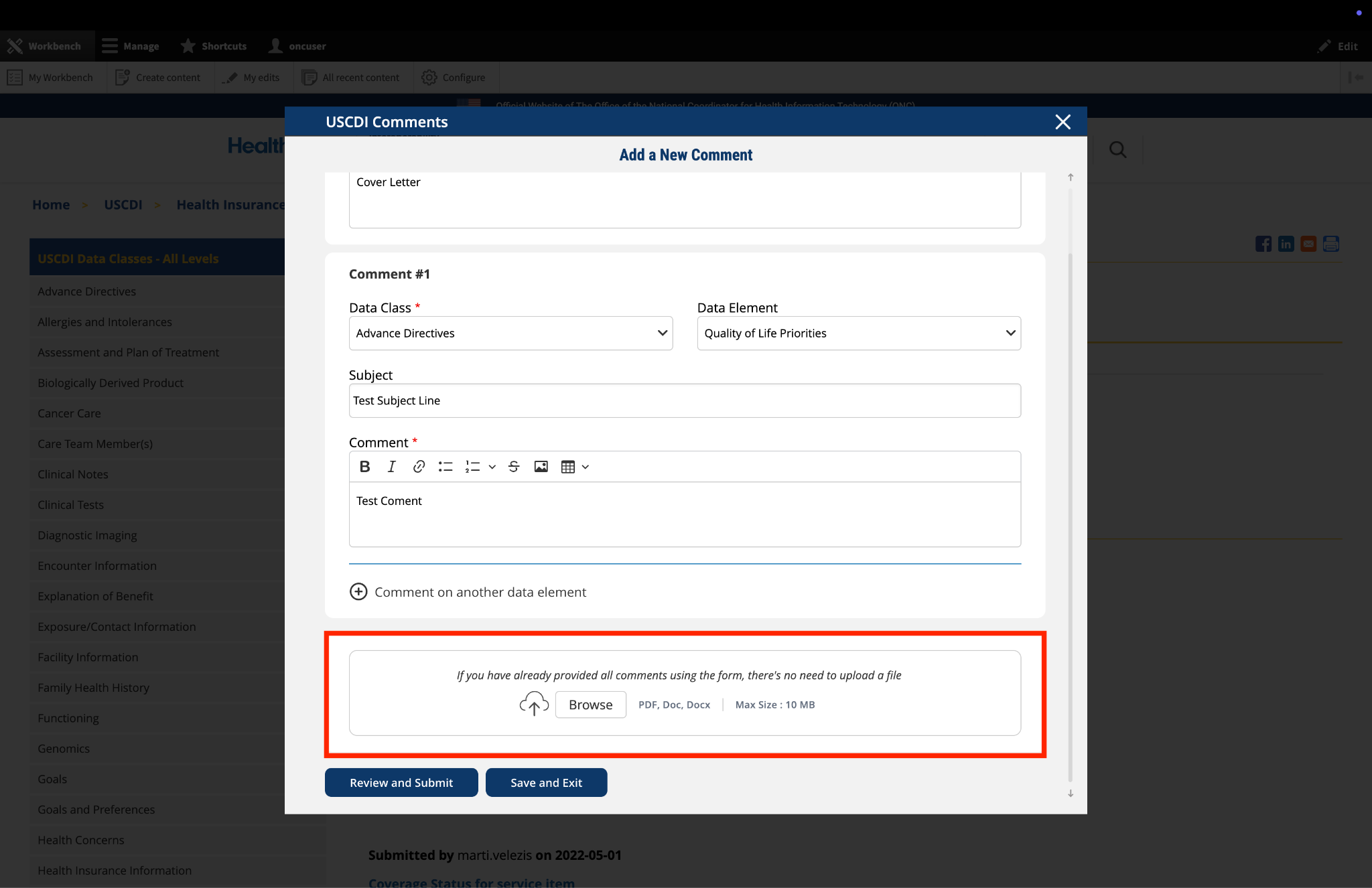
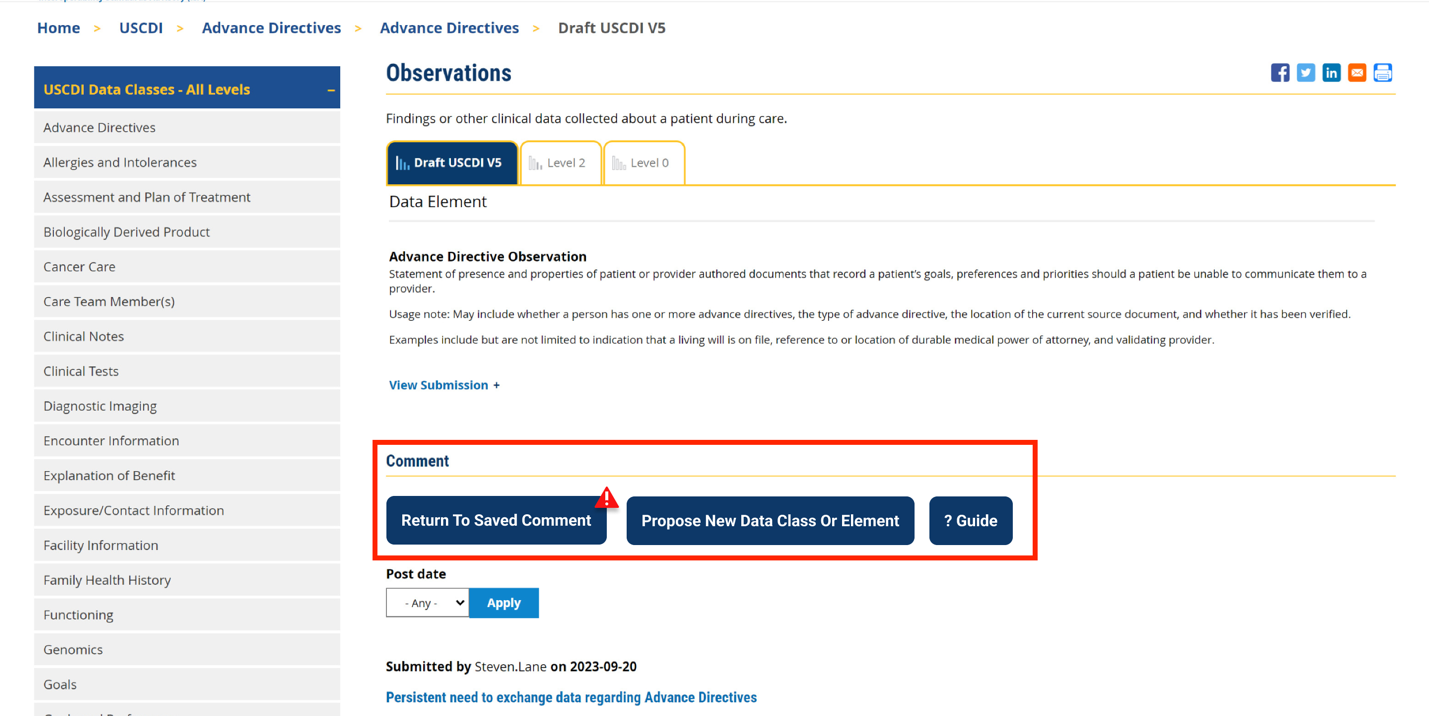
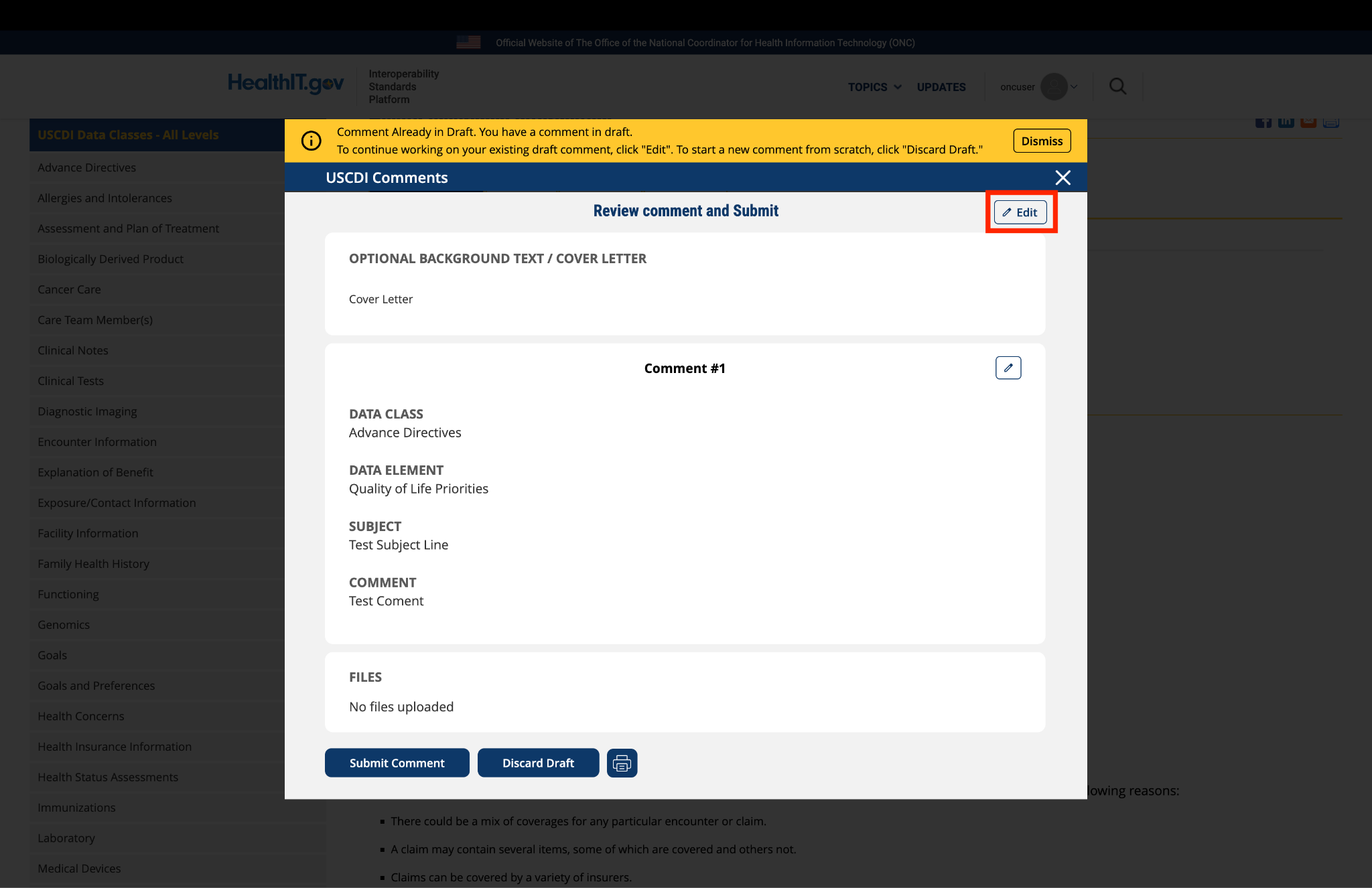
Submitted by nedragarrett_CDC on
CDC's Consolidated Comment for USCDI v4
CDC continues to recommend inclusion of this high priority data element in USCDI v4